

ARTIFICIAL INTELLIGENCE IN MEDICINE
ARGONNE NATIONAL LABORATORY ADVANCEMENTS

















ARTIFICIAL INTELLIGENCE IN MEDICINE
ARGONNE NATIONAL LABORATORY ADVANCEMENTS














As I write this, it is exactly six years ago to the day that I sat down with Scott Jonlich to discuss launching a magazine dedicated to our community of Downers Grove. The time has flown by. I have learned an incredible amount about our town, people, businesses, organizations, and, admittedly, myself. I am grateful that our magazine continues to thrive due to our dedicated advertising partners, readers, and amazing staff of writers and designers. Thank you for indulging me and letting me celebrate this personal milestone.
We are always proud to spotlight individuals pushing boundaries and leaving meaningful legacies. First, we begin with Dr. Michael Byun, whose work blends artistry and science with a philosophy centered on honoring one’s natural beauty—a refreshing and deeply human approach. We are also proud to feature other medical professionals in our NOTEWORTHY section and their journeys in a variety of fields.

Our community spirit truly shines through. In celebration of National Police Week, we also profile Sergeant Robert Jacobs, a lifelong Downers Grove resident, reminds us that public service is built on quiet acts of everyday heroism, while Eagle Scout Millan Ananth’s gym renovation shows us how one student can literally reshape a school.
In sports, the Downers Grove Co-Op gymnastics team has brought home a state title, a testament to both talent and tenacity.
We’re also proud to spotlight the Evans Scholars Foundation, which continues to transform lives through college scholarships for golf caddies, proving that hard work and opportunity can open doors to a brighter future. And in a powerful story linking sports and global history, we revisit the 1980 Olympic games through the lens of one local hockey athlete whose story still echoes of emotion and pride.
In that same spirit of purpose and transformation, we highlight the remarkable work in artificial intelligence and healthcare, with experts at Argonne and the University of Chicago leading the charge. These advancements aren’t just futuristic—they’re already changing how we experience care today.
Happy reading Downers Grove. We are grateful to share this journey with you. Here’s to a summer season of connection, discovery, and celebration.
Sincerely,
Anne Healy Associate Publisher anne@HinsdaleMag.com
FOUNDER & PUBLISHER
Scott Jonlich sjonlich@HinsdaleMag.com
GROUP PUBLISHER
Anne Healy anne@HinsdaleMag.com







MANAGING EDITOR
Larry Atseff larry@HinsdaleMag.com
CONTRIBUTING EDITORS
Maureen Callahan
Valerie Hardy
Anna Hughes
GRAPHIC DESIGNERS
Rachel Pavlovich
Jennifer Frencl
Katie Bolinger
CONTRIBUTING WRITERS
Chuck Fieldman
Jeff Vorva
Jack Rodak
FEATURE PHOTOGRAPHERS
Madeline Craig
Victor Hilitski
Greg Kozlick Atticus Fair, Video Editor
ADVERTISING SALES graphics@hinsdalemag.com
Hinsdale Magazine Group 3 Grant Square#201 Hinsdale, IL 60521 630-655-3400 www.DownersGroveMag.com

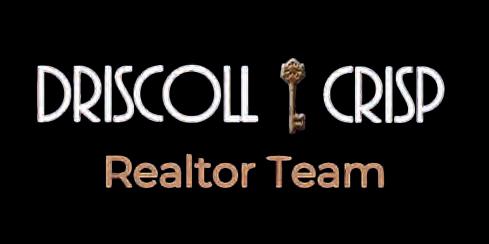













With summer break fast approaching, we’ve curated a list of local activities for the entire family to enjoy. Whether you’re looking for memorable musical performances or fun in the sun, we’ve got all that and more on this season’s selection of the best in the western suburbs.
BY ANNA HUGHES
Paramount Theatre Aurora April 30-June 15 ParamountAurora.com
Paramount’s creative team has re-envisioned this classic musical, bringing a new layer and energy to this Broadwaystaple. Cats was inspired by a collection of poems by T.S. Eliot, from which the legendary Andrew Lloyd Webber crafted an unforgettable score and story. The show has been bringing audiences into the fantastic world of Jellicle Cats since its inception in 1981. Cats is the winner of seven Tony Awards, including Best Musical, Best Book of a Musical, and Best Original Score. Showtimes vary by date.
INAUGURAL
ELMHURST HISTORY MUSEUM CONCERT
June 6, 6:30 PM Elmhurst History Museum ElmhurstHistory.org
The Elmhurst History Museum is celebrating the opening of their new public, outdoor performance space with an inaugural concert,
and they want you to join in on the festivities! There will be a ribbon cutting and remarks from the museum team before a performance by the Elmhurst Symphony Orchestra. Guests can bring chairs, blankets, and coolers, and the event is free to all attendees.
HINSDALE FINE ARTS FESTIVAL
June 7-8, 10 AM-4 PM Burlington Park HinsdaleChamber.com
The Hinsdale Chamber of Commerce proudly presents the 52nd Annual Fine Arts Festival. This summer staple during the first weekend of June brings people from all over the Chicagoland area to Hinsdale. Walk
through Burlington Park, and enjoy a variety of booths featuring unique, classy, and fun fine art from over 85 different artists.
ELMHURST CENTRE FOR PERFORMING ARTS: AN INTIMATE EVENING WITH MIGUEL CERVANTES

June 12 at 7:00 PM Hammerschmidt Chapel in Elmhurst ECPA-Elmhurst.org
No one has been Hamilton longer, except Alexander himself. Best known for the role of Alexander Hamilton in the Chicago and Broadway productions of Hamilton for nearly


eight years, Miguel Cervantes grew up in Dallas where he attended Booker T. Washington followed by Emerson College, where he earned his BFA. ECPA presents “An Intimate Evening with Miguel Cervantes” with guest artist Julie Peterson (York HS 2010; The Boston Conservatory BFA, 2014).
SONNY ACRES PRO RODEO
June 13-14, 20-22
Sonny Acres Farm SonnyAcres.com
Grab your hats and boots and saddle up for a local experience like no other. Sonny Acres Farm proudly presents their 3rd Annual Pro Rodeo, complete with
bareback riding, steer wrestling, saddle bronc riding, girls breakaway roping, cowgirls barrel racing, bull riding, and much more. This event is perfect for the whole family and will also include great food, amusement rides, pony rides, and a self-feed petting zoo. Tickets are available on their website, where you can find times and activities for each day.
June 19-22
Downtown Downers Grove RotaryGroveFest.com
Downtown Downers Grove will transform into a carnival celebration for four days to kick off the start of the summer. The event is fitting for all ages, and it will include an array of rides, fantastic musical performances, a beer garden, and a car show. All proceeds from the event benefit local, regional, and national charities, including 27 nonprofit organizations that support causes in and around Downers Grove. Presale tickets are on sale now.
June 21, 9 AM-2 PM
DuPage Children’s Museum
DupageChildrens.org

can—and love to—be messy. That’s why they’ve dedicated an entire event to embracing the mess and letting kids be kids without any of the consequences. Visitors can enjoy a mud kitchen, shaving cream block building, and all kinds of slime, along with entry to the museum (after a trip to the wash station, of course). Participants should bring a change of clothes and shoes and be prepared to get messy!
June 26, 5:30 PM-8 PM Oak Brook Park District OBParks.org
In the midst of family fun this summer, don’t forget to include your furry friends in some of the activities. Barks & Brews, hosted by the Oak Brook Park District, is the perfect opportunity to give your dogs a paw-some play date. Pups will enjoy fun activities like peanut

DuPage Children’s Museum knows that kids
butter eating and best trick contests, prizes, and even pup-trivia. Attendees who bring three items to donate to their annual pet drive will be entered into a raffle to win prizes. Registration is required, and dogs must be kept on a leash for the entirety of the event. ■
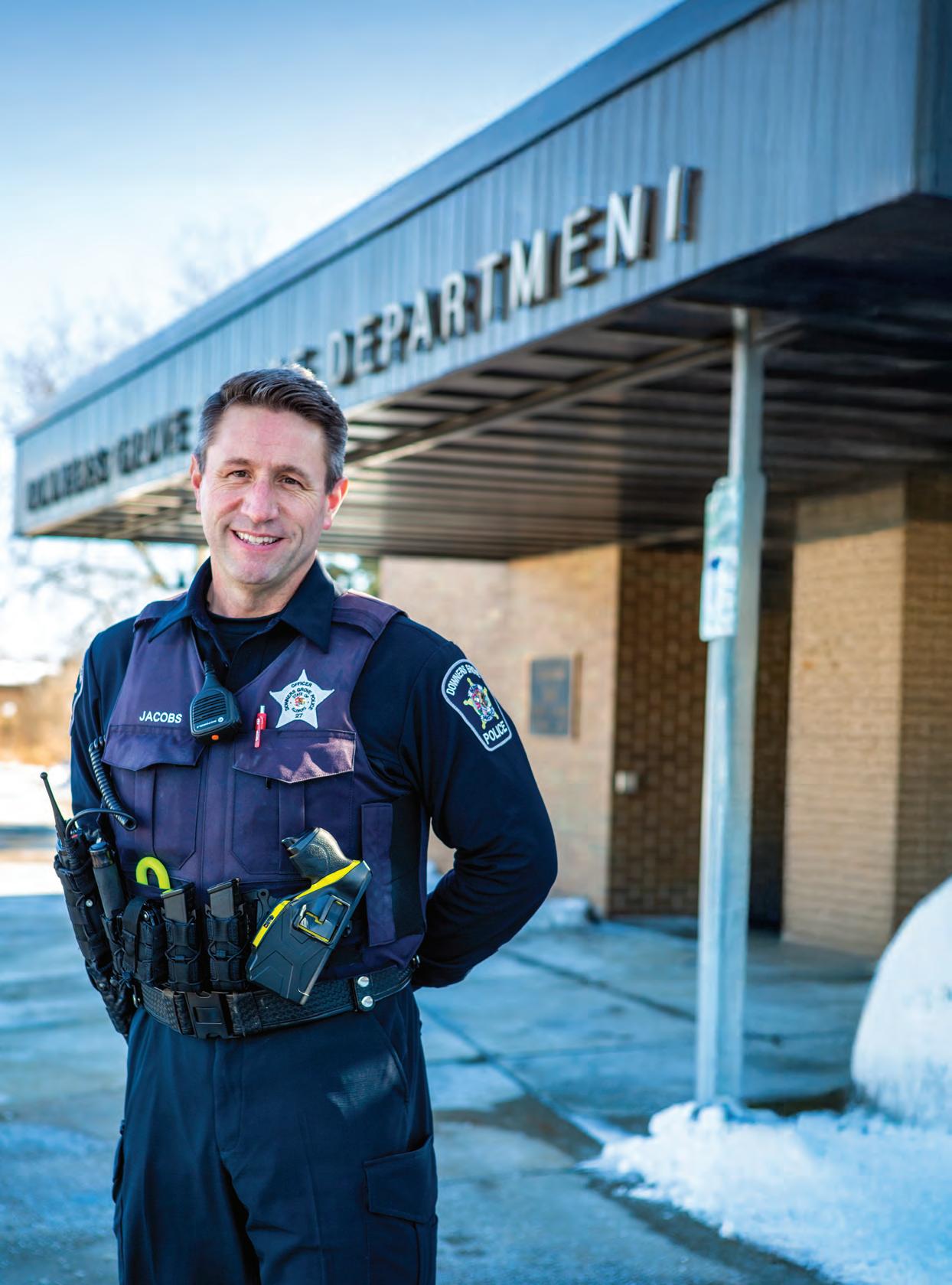
Sergeant Robert Jacobs has served nearly three decades with the Downers Grove Police Department
BY MAUREEN CALLAHAN
here’s something about being from a place, especially if you choose to stay in that place and raise your family—just ask Sergeant Robert Jacobs of the Downers Grove Police Department (DGPD). After having grown up in town and serving almost three decades with the DGPD (33 years of law enforcement in total), Jacobs is not only a familiar face around town but also a reminder of the trust and respect we have for
and recognition to those

Jacobs attended Augustana College in Rock Island. With initial aspirations to become a dentist, he ended up finishing with a business degree. A few years after graduation, a friend talked him into taking the police test.
“Like everyone else, I began as a patrolman, where I served my probationary time,” Jacobs relayed. “I started my career in Indian Head Park, where I served four years before coming to Downers Grove. But the beginning is tough anywhere. You’re answering 911 calls and learning how to react to all kinds of situations.”
Shortly after, Jacobs was trained as an evidence technician. That aspect of the job includes working on various types of crime scenes to collect fingerprints and blood samples. “Once an officer is certified, they’re put on call,” said Jacobs. “So, you might get called to work a crime scene in the middle of the night.”
At one time, DGPD sponsored a community policing unit. Nine officers oversaw two resource centers in town. The group ran afterschool programs, mainly for underserved local grade school students, that offered a safe space for kids to get help with homework from tutors, have a snack, and basically be finished with any academic obligations by the time they were picked up by their parents. The program also saw the DGPD partner with businesses, such as Home Depot, who donated materials as the officers taught the kids to make improvements by
anybody, but I have been threatened with weapons myself a few times,” he said. “In those circumstances, you’re forced to make decisions based on the behavior that’s going on in that moment. We always try to de-escalate a situation before using any other means.”
“The thing I like most about law enforcement is that it’s never the same job two days in a row. That and knowing you can contribute to the community in a meaningful way are what makes it all worthwhile.”
– SERGEANT ROBERT JACOBS, DGPD
working on properties around town.
Crisis intervention is another aspect of the job that has escalated quite a bit over the past decade, with mental health having become a much greater issue since the time Jacobs started his career. DGPD gets calls relevant to this issue almost daily. Fortunately, the department has created a collaboration with Good Samaritan Hospital to work through situations that involve mental health issues. “It’s definitely a new challenge for a new frontier that honestly evolves every day,” Jacobs relayed. “Fortunately, we are able to partner with the village social worker as well to be sure people in this situation are able to get the continuing care they need.”
As new officers graduate from the Police Academy, they are hired by individual police departments. From there, they are paired with field training officers, who serve as mentors. More experienced police people offer advice and counsel as a new hire learns the job. This is another program in which Jacobs has been involved for most of his career. “Field training officers impart their knowledge while walking new police officers through the steps they need to take to enforce the law in particular scenarios,” said Jacobs. “I now enjoy running and supervising that program.”
“I still hear from kids now who went on to become professionals. They reach back out and tell me how they’re doing and how much that program helped them,” Jacobs remembered with a smile. “To have made an impact on a kid’s life in that way and have had the opportunity to be a positive figure in their lives has been one of the best things about this job.”
At this point in time, there aren’t many departmental aspects of which Jacobs hasn’t been a part. Over the years, several serious situations have required SWAT Team intervention. “I’ve never had to shoot at
There are so many things the police do to keep us safe and improve the community. But to our local blueblooded officers like Sergeant Jacobs, it’s all in a day’s work. “We like to think we keep the blanket pulled up right around your neck at night, so you feel safe and don’t have to worry about a thing,” he said.
Downers Grove Magazine takes its hat off to our hometown police department in recognition of the sacrifices made daily by this dedicated group of citizens. For the time you put in and the offenders you take out, we offer our thanks and respect.


























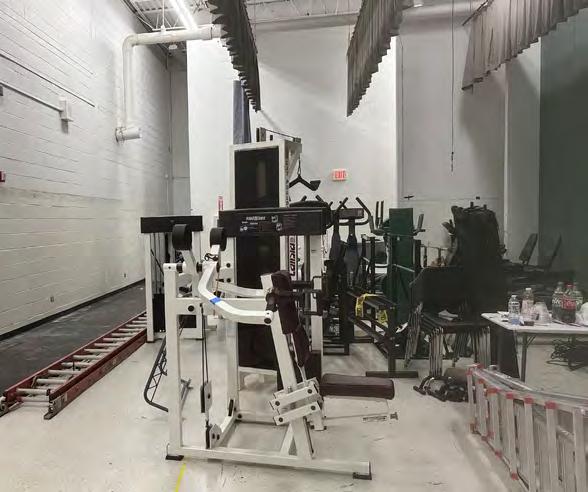

Ananth dedicated much of his 2024 summer break to painting and installing new flooring in the weight room. The new fitness equipment was added in August and September, then some of Lakeview’s staff – led by head custodian Mr. Ed Ruby – completed finishing touches in October. “I wanted capable adults at the school to make sure everything was put together correctly…for the safety of the students,” Ananth said.
"People I barely know or talk to were so generous in supporting me giving back to my community.”
- MILLAN ANANTH
He submitted his project report this February and passed his Eagle Board review the week before spring break.
Ananth logged 200 planning hours and 60 hands-on hours, but the entire project took nearly 800 hours. The renovation was only possible because Ananth assembled a strong group of volunteers.
“The rule of thumb when it comes to Eagle projects is that if you go to someone else’s to help, they’ll be more inclined to help with your project,” Ananth explained.
So, he said, it was no surprise that many of his “Scout buddies” stepped up to assist with the renovation. Other friends and family members also helped. “I’m indebted to them for life,” Ananth said.
Ananth has relished in the fruits of his (and his team’s) labors. Hearing others’ feedback “is the coolest part,” he said.
“I know a bunch of eighth graders at Lakeview, and they texted me about how great the weight room is,” Ananth said. “[Lakeview PE teacher and coach Mr.
Dave] Dvorak said they want to be in there every day, which has the biggest impact.”
Besides pride in the finished project, Ananth will carry forward the skills he gained through the process, including communication, budgeting, leadership, problem prevention and problem-solving, and patience.
Ananth joined Cub Scouts when he was in first grade. He was in Pack 48 out of Darien before “crossing over” into Troop 55 out of Downers Grove at the end of fifth grade. Troop 55 has operated out of First Congregational Church since 1929 and is the sixtholdest troop in Illinois.
Ananth also served in various Scout leadership positions, including the highest one: senior patrol leader.
He said it is a “weird feeling” to know he is done advancing within Scouts. However, he is committed to staying involved in the organization - attending Scout meetings, summer camps, and camping trips. He will just focus a little more on the leisure components now that he does not have to work toward merit badges to advance in rank.
Most immediately, Ananth wants to head back to Lakeview to see the weight room now that the final punch list items requiring staff attention have been completed. “I also want to come back to Lakeview in 20 years to see it,” Ananth said. “I hope it’s still the same weight room!” ■
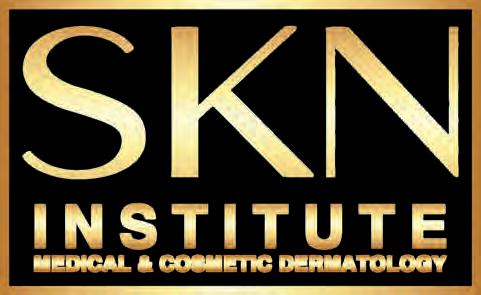





BY VALERIE HARDY
Dr. Rachael Mahmood grew up in Downers Grove with parents who were both physicians at Good Samaritan Hospital. “Being the child of two doctors, I felt like I had no choice but to become a doctor,” she said.
In fact, back when Mahmood was a teenager, her father told her he would buy her a car if she became a doctor, but if she became a teacher, he would buy her a bicycle. Mahmood understood the roots of her father’s offer: “he had come to America to live the American Dream and wanted his kids to follow in his footsteps,” she explained.
However, Mahmood followed her heart instead and attended Benedictine University to study education. One of her professors noticed her interest in multicultural education and invited her to attend meetings in Indian Prairie District 204 – the professor’s children’s school district – that focused on increasing inclusivity in its schools. “I went to these
meetings with her for my entire senior year because I was interested in all the educators, principals, and parents working together to make their schools more inclusive,” Mahmood said.
“Take care of our teachers, because they take care of the greatest resource in our community: our children.”
– DR. RACHAEL MAHMOOD, ILLINOIS TEACHER OF THE YEAR
Mahmood’s first teaching position was at Brookdale Elementary School in Naperville, where she was eager to carry District 204’s value of inclusivity into her classroom to ensure all her students felt a sense of belonging.
“I didn’t really have that experience in school,” Mahmood explained. “I
loved all my teachers and loved school, but my mom is Russian-Jewish, and my dad is Indian-Hindu, and I just never felt a place of belonging as a student.”
She added that there were “a lot of micro-messages being sent through the curriculum and through the school calendar…whispering to me that my identity was not normal.”
Mahmood is committed to using her position as an educator to prevent other students from feeling a similar invalidation of their unique identities. Despite not always feeling like she has the power as an individual to increase inclusivity and belongingness in schools, over the course of her 20 years as an educator, Mahmood has continually tried to do so.
After spending the first half of her career at Brookdale, she transferred to District 204’s Georgetown Elementary School, which has a racially and socioeconomically diverse student population. Always a fourth or fifth-grade teacher as her primary


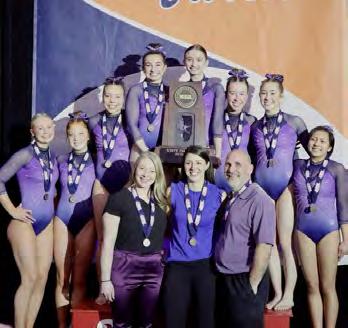
I really took a different approach to it. We did a lot more mental health training, handling anxiety and expectations, and working together as a team. Our motto changed this year into managing what we can do and not what anyone else can do. We set our own expectations.”
Senior Genevieve Herion closed her storied career on a huge note, winning the all-around title with a 38.075 and winning the balance team with a 9.575. She is the first gymnast since 2014 to win back-toback titles on the beam. She won in 2024 with a 9.525.
The word on her arm was “confidence.”
“I chose that word because my whole season, I wanted to build my confidence, and it was a reminder that I can do it,” she said. “I knew I was going to go out there and do my best, and I knew that a little confidence goes a long way.”
Herion, a Downers Grove South student, will leave the school with seven state medals.
“She’s been here three years, but her impact was quite significant to the team and to the program,” Campos said of Herion. “I know she wanted that title. That was one of her goals. Even if she wouldn’t say it, I know it was. To see her have success, my gosh, I couldn’t be more proud of her. That’s all you want as a coach. You want to see them happy, smiling, and proud of themselves, and I think she accomplished everything she could have.”
“This season has been one of the best ever because of my teammates and coaches.”
-
GENEVIEVE HERION
Herion also finished second on the vault with a 9.6750. Sophomore teammate Caroline Phillip took seventh in that event with a 9.2450, and junior Kaelyn Landry was 11th with a 9.2500.
Landry took fifth place in the uneven parallel bars with a 9.745, and Herion was sixth with a 9.245. She also claimed eighth in the floor exercise event with 9.100.
Sophomore Edith Condon, junior Emilie Kutcha, and senior Allison Palansky also qualified for the state meet.
Herion was scheduled to appear in a national meet in Florida in May
and then call it a career. She plans on pursuing a nursing degree. She developed a love for helping people while taking care of her brother, Calvin, 25, who has been in a wheelchair and ventilator all of his life.
“He’s still a big part of my life and I love him,” Herion said of her brother. “When I was little, I always wanted to help out with him. I help feed him and clean him and I love to play video games with him.”
The 18-year-old Herion said she was in gymnastics when she was two and loved “flipping around.” She will miss it.
“It’s definitely bittersweet,” she said. “I can’t believe this chapter of my life is coming to a close. This is something I have done my whole life. But I’ve had a really great experience, especially in my final year. This season has been one of the best ever because of my teammates and coaches.” ■


BY HINSDALE MAGAZINE GROUP STAFF
For decades, the evolution of plastic surgery has been shaped by idealized images of beauty relentlessly presented through media. This pursuit of seemingly unattainable facial perfection; a straighter nose, defined jawline, and youthful appearance, often drives patients to travel far to achieve these results.
Many patients embark on a journey through multiple surgeons and treatments, each with varying philosophies; however, we may have reached a turning point. The era of skin-pulling, artificial implants and fillers, popularized by
reality television trends, has yielded unnatural and temporary results, often at the cost of individual identity.
Now, in 2025, a pioneering Chicagoarea surgeon is redefining facial rejuvenation. He champions the rediscovery of one’s true essence and a path to graceful aging.
Byun’s reputation as a distinguished plastic surgeon reflects a journey deeply rooted in his family’s legacy. As the eldest of four, he carries the combined influences of a scholarly Japanese mother and a driven Korean father, whose family played a crucial role in South Korea’s
construction industry. His father’s leadership and work on the nation’s highway system exemplify the family’s commitment to hard work and progress, qualities that have undoubtedly shaped Byun’s own character and professional trajectory.
Byun’s innate curiosity and ambition were evident from a young age. His fascination with the fusion of art and science manifested early. A memorable school project, where students were tasked with building a plane from popsicle sticks, paper, and glue, showcased his exceptional problem-solving and creative


skin outward, widening the face. Your skin is uniquely yours and incredibly precious. It’s crucial not to underestimate its importance.
Byun’s philosophy is rooted in creating results that stand the test of time. His approach contrasts sharply with the quick-fix mentality that dominates the cosmetic surgery industry. Many surgeons promise immediate results but
Byun views the facial muscles as interlocking puzzle pieces. His technique focuses on precisely repositioning these muscles back into their original anatomical pockets. This restoration naturally contours the face, eliminating the need for excessive skin removal. The skin drapes smoothly by aligning the muscles along their natural convexity towards the midline, revealing beautifully restored muscle contours.
In some cases, previous procedures may have removed too much skin, which is essential for this natural draping process. Byun warns his patients of this through education. In cases where a patient has had multiple prior facelifts, it could end up that there’s not enough skin left to achieve an optimal outcome; you can’t just create new skin. Be wary of surgeons who essentially discarded valuable tissue – by cutting it away and pulling the remaining
What troubled me was the accelerated aging I observed in patients who had undergone traditional cosmetic procedures. The long-term effects of fat grafts, fillers, and skin-tightening devices were often detrimental; moreover, the crucial issue of sagging facial muscles was consistently overlooked.
– DR. MICHAEL BYUN
fail to consider the long-term effects of repeated procedures. His extensive experience spans diverse patient demographics worldwide, including individuals from every continent. Through years of meticulous monitoring and personalized adjustments, he has consistently learned and refined his techniques with each patient. This method promotes natural, graceful aging, allowing patients to retain their inherent beauty. Byun’s singular technique draws patients globally, as no other surgeon offers this level of expertise.
Byun’s work reflects his Eastern and Western influences and his early bicultural household, giving him a unique perspective on beauty, balance, and harmony. As he continues to explore creative outlets, he still believes the principles of art (balance, proportion, and harmony) are deeply connected to plastic surgery.
Having a flair for art and science,









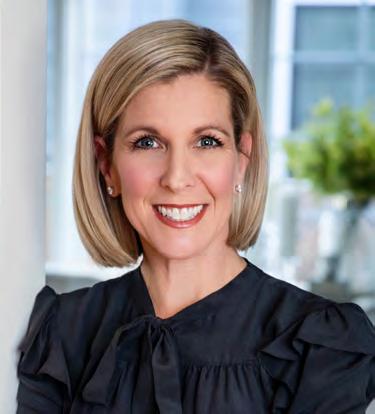

Experience Chicagoland’s Ultimate Sky Show with Spectacular Fireworks and a Dazzling Drone Show
THURSDAY July 3 Gates Open at 4pm Sky Show at Dusk FREE ADMISSION Plus! Kids Entertainment: Inflatable fun, face painters and more!

For pre-purchased parking and more information visit: www.oak-brook.org/taste

Enjoy “Taste” Size Portions from your Favorite Local Restaurants


Live Music featuring (Unofficial Taylor Tribute Band) Returning Headliner












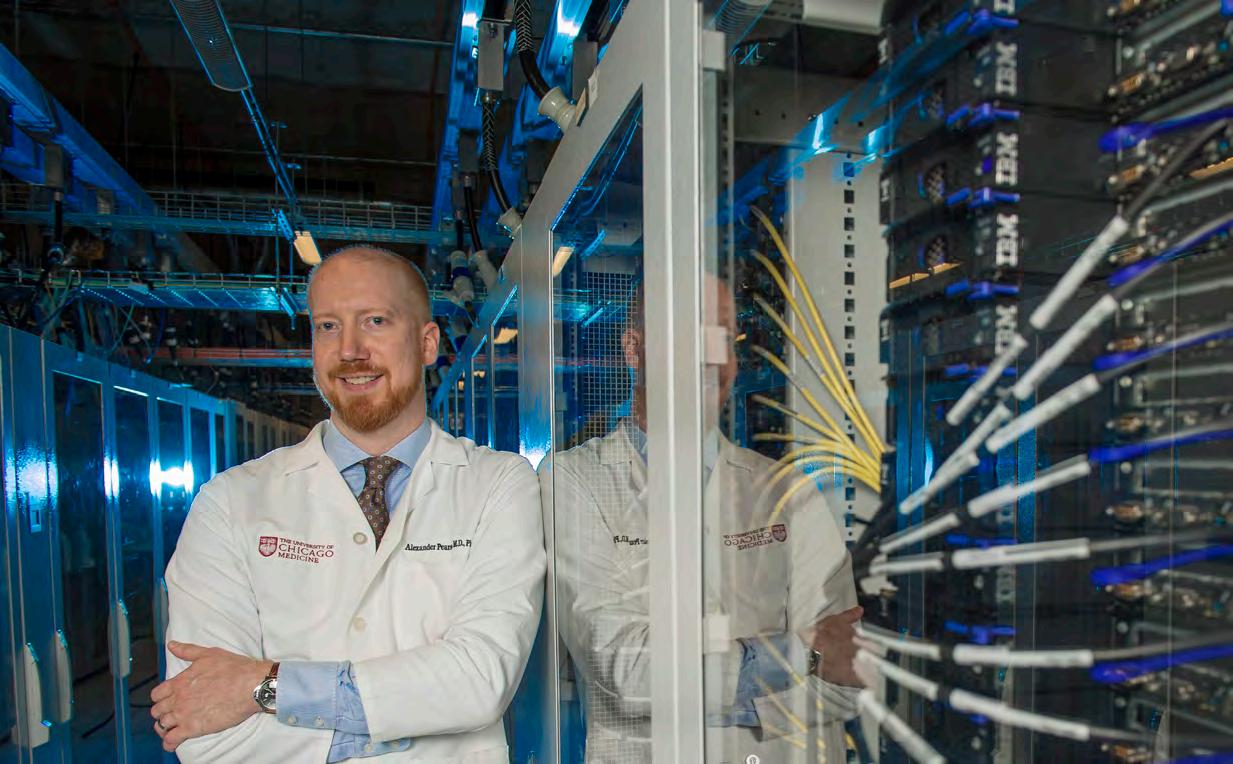

Medical training programs and practices in Illinois are on the cutting edge when it comes to considering how artificial intelligence (AI) can enhance patient care and physician functionality. For example, the University of Illinois at Urbana-Champaign’s Department of Bioengineering was the first to offer an AI in Medicine Certificate Program for healthcare professionals.
This six-week continuing education program provided physicians, medical students, and other clinicians with information about the latest in digital medicine and practical applications for it via case studies involving machine learning. Additionally, the course addressed ethical and legal considerations related to the use of AI in clinical settings.
BY VALERIE HARDY
“Because the [AI in Medicine] field is still young, structured training programs are just beginning to emerge – but there’s strong interest and growing engagement at all levels,” Beiser added.
Fellow physician Dr. Alexander Pearson, who holds an MD, a PhD in statistics, and is an Associate Professor of Medicine specializing in hematology and oncology, is working to expand the machine learning and data science curriculum at UChicago’s Pritzker School of Medicine. He also runs the Center for Computational Medicine and Clinical Artificial Intelligence.
Pearson said that he is frequently asked when AI is going to arrive within the medical field, and his prognosis is that “it’s already here, and its capabilities are only increasing.”
efficiency and quality of patient care. Both Beiser and Pearson now use ambient notetaking tools, which use AI to automatically transcribe and summarize conversations between healthcare providers and their patients, allowing them to look their patients in the eye rather than at the notes on their computer screen.
According to Beiser, AI is best used in the medical field when it “offload[s] the mundane and repetitive aspects of clinical work, allowing physicians to focus more on higher-level decision making, big-picture thinking, and building stronger connections with our patients.”



Likewise, while University of Chicago (UChicago) medical faculty and students are not formally trained in the use of AI for clinical purposes, “there are frequent seminars, grand rounds, and journal clubs addressing AI’s role in medicine,” explained Dr. David Beiser, an emergency physician, clinical scientist and informaticist, and Associate Professor of Medicine at UChicago.
An early use of AI in medicine is in mammography, with most mammograms in the United States having a “computer-assisted diagnostic component,” explained Pearson. He further noted how AI can help radiologists complete diagnostic tasks more cost-effectively, efficiently, and accurately.
Documentation is another area in which AI increases physician
Ironically, AI may offer more empathetic responses to patients than human doctors can. This is because in busy clinical settings, doctors may tend toward “accurate but rushed” communication with patients, unintentionally forgetting to respond with compassionate language, Pearson said, while “large language models never have to get home to their kids,” so they can allocate unlimited time toward acknowledging patients’ symptoms and emotions.
Medical trainees also have access to “large language models, with huge amounts of data at the elbow to
Using the Advanced Photon Source, researchers are creating smart proteins to better monitor diseases like cancer and thyroid disorders
BY CONTRIBUTING PARTNER ARGONNE NATIONAL LABORATORY
Ateam led by Nobel Prize winner David Baker used artificial intelligence and the Advanced Photon Source to design proteins that sense key molecules in the body. This work could lead to easier and more accurate health monitoring, from cancer treatment to liver and thyroid testing.
Some of the most important molecules in our bodies—like those used in cancer treatments or

that signal thyroid issues—are tiny and hard to track. Scientists need tools to detect these “small molecules” quickly and reliably. That’s where a breakthrough from the University of Washington comes in.
Working with the U.S. Department of Energy’s (DOE) Argonne National Laboratory, a team led by Nobel Prize-winning scientist David Baker created proteins that can detect these small molecules in new ways. This work was
made possible by the powerful X-rays at the Advanced Photon Source (APS), a DOE Office of Science user facility at Argonne.
To develop these new protein sensors, the team used artificial intelligence. Their goal was to build proteins that could find and attach to small molecules—like methotrexate, a common cancer drug, or thyroxine, a hormone related to thyroid health. Once a protein finds one of these molecules, it sends out a signal, similar to how a COVID test changes color to show a positive result.
The APS was crucial in this process. After designing the proteins using computer models, the team used APS’s ultrabright X-rays to examine the actual shape of the proteins at the atomic level. This helped confirm that the designs worked in real life—not just in simulations.
“These X-rays help us see the exact structure of the proteins,” said Kay Perry, a scientist with the Northeastern Collaborative Access Team at the APS.



“It’s one of the best ways to make sure any computer predictions are accurate.”
“Smart” sensors are proteins that light up or block electrical signals whenever they detect certain molecules. These signals can then be measured easily, like flipping a switch when the right molecule is present. Previously, scientists needed to iteratively test through many trials when developing such a “smart” sensor. Baker’s work provides a pathway to faster and more accurate “smart” sensor design.
These sensors could one day be used at home to monitor health conditions like liver disease, cancer, or thyroid problems. Today’s tests often can’t tell the difference between similar molecules, but these new protein-based sensors are much more specific.
Beyond medicine, the team is also looking at ways to use the technology to detect pollutants like microplastics or harmful chemicals in the environment.
This work was supported by the DOE Office of Science. ■






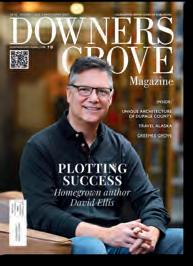


Mary’s knowledge, experience, and hard work made for great results for us
We chose Mary because of the work she had done to research the property value and the approach she took to pricing and marketing. Her knowledge and experience were helpful tools, and she worked hard to get us the best price, which was a cash offer for slightly more than the asking price. The house sold quickly and closed within a few weeks of our first meeting with Mary. We were very pleased with her work on our behalf.






Welcome to NOTEWORTHY where we spotlight leaders in healthcare across various disciplines. In this issue, we celebrate the trailblazers who are not only advancing medical knowledge but also transforming patient care. With a commitment to innovation, compassion, and excellence, these distinguished professionals represent the heart of a dynamic industry dedicated to healing, discovery, and progress. Join Hinsdale Magazine Group as we explore their inspiring stories, exceptional achievements, and the latest advancements in the ever-evolving world of healthcare.

Downers Grove Magazine (DGM): People are increasingly concerned about the prevalence of varicose veins. How is your clinic addressing this issue through symptom awareness, treatment options, and prevention?
Our Oak Brook and Chicago locations offer convenience, and we work with many PPO insurances and Medicare to make treatment accessible. Ultimately, we want our patients not only to feel better but also to regain confidence in their appearance and mobility.
Our Oak Brook and Chicago locations offer convenience, and we work with many PPO insurances and Medicare to make treatment accessible. Ultimately, we want our patients not only to feel better but also to regain confidence in their appearance and mobility.
DGM: How do you distinguish your practice from other vein treatment providers in the area?
DGM: How do you distinguish your practice from other vein treatment providers in the area?
Dr. Abboud: With more than 30 years of medical experience, I bring a deep understanding of both the medical and cosmetic aspects of vein care. At Charming Skin Vein Clinics, we combine clinical expertise with the latest technology to deliver customized care. Our focus is always on the individual patient, and we strive to make treatment as effective and comfortable as possible. That personal approach, paired with our clinical capabilities, truly sets us apart.
Dr. Abboud: With more than 30 years of medical experience, I bring a deep understanding of both the medical and cosmetic aspects of vein care. At Charming Skin Vein Clinics, we combine clinical expertise with the latest technology to deliver customized care. Our focus is always on the individual patient, and we strive to make treatment as effective and comfortable as possible. That personal approach, paired with our clinical capabilities, truly sets us apart.
DGM: What are the most common symptoms of varicose veins, and when should someone consider seeing a doctor?
Downers Grove Magazine (DGM): People are increasingly concerned about the prevalence of varicose veins. How is your clinic addressing this issue through symptom awareness, treatment options, and prevention?
Jawdat Abboud, MD: At Charming Skin Vein Clinics, we specialize in diagnosing and treating varicose veins and related venous conditions with a patient-first mindset. Many people live with discomfort for too long without realizing help is available. Symptoms like aching, swelling, heaviness in the legs, and bulging blue or purple veins are signs that shouldn’t be ignored.
Jawdat Abboud, MD: At Charming Skin Vein Clinics, we specialize in diagnosing and treating varicose veins and related venous conditions with a patient-first mindset. Many people live with discomfort for too long without realizing help is available. Symptoms like aching, swelling, heaviness in the legs, and bulging blue or purple veins are signs that shouldn’t be ignored.
Our treatments are minimally invasive and include Endovenous Laser Treatment (EVLT), sclerotherapy, and, in more advanced cases, vein stripping and ligation. We use advanced diagnostic tools, like Doppler ultrasound, to ensure precision and effectiveness. We also emphasize education—helping patients understand how lifestyle changes, like staying active and wearing compression garments, can reduce symptoms or even prevent progression.
DGM: What are the most common symptoms of varicose veins, and when should someone consider seeing a doctor?
Dr. Abboud: The most common symptoms include visibly twisted or bulging veins, especially on the legs, aching or heavy legs (often worse after standing or sitting for long periods), and swelling in the ankles or feet. Some patients experience burning, throbbing, cramping (especially at night), or itching around the affected area. In more advanced cases, the skin may become discolored, dry, or irritated.
Dr. Abboud: The most common symptoms include visibly twisted or bulging veins, especially on the legs, aching or heavy legs (often worse after standing or sitting for long periods), and swelling in the ankles or feet. Some patients experience burning, throbbing, cramping (especially at night), or itching around the affected area. In more advanced cases, the skin may become discolored, dry, or irritated.
You should seek medical care if you notice worsening pain, swelling, or skin changes—especially if ulcers or bleeding occur. Early intervention can prevent complications like blood clots or skin breakdown, and timely care significantly improves both comfort and outcomes.
Our treatments are minimally invasive and include Endovenous Laser Treatment (EVLT), sclerotherapy, and, in more advanced cases, vein stripping and ligation. We use advanced diagnostic tools, like Doppler ultrasound, to ensure precision and effectiveness. We also emphasize education—helping patients understand how lifestyle changes, like staying active and wearing compression garments, can reduce symptoms or even prevent progression.
You should seek medical care if you notice worsening pain, swelling, or skin changes—especially if ulcers or bleeding occur. Early intervention can prevent complications like blood clots or skin breakdown, and timely care significantly improves both comfort and outcomes.
Charming Skin Vein Clinics 2425 W 22nd St., Suite 103, Oak Brook, Illinois 630-974-1400 charmingskin.com
Charming Skin Vein Clinics 2425 W 22nd St., Suite 103, Oak Brook, Illinois 630-974-1400 charmingskin.com
Downers Grove Magazine (DGM): What motivates you to get up and go to work every day?
Dr. Beejal Amin: What motivates me daily as a neurosurgeon is the opportunity to change lives. Whether it’s helping a patient walk again, relieving debilitating pain, or giving someone hope where there was none, I find purpose in making a real difference. I’m also driven by the challenge—pushing the boundaries of what’s possible in spine care, integrating digital health and AI, and expanding access to specialized treatment. Knowing that my work impacts not only patients, but also the future of neurosurgery, keeps me inspired to keep going. I am also proud of my work helping to build one of the most comprehensive neuroscience programs in the Chicagoland area at UChicago Medicine AdventHealth.
DGM: How do you build trust with your patients?
Dr. Amin: Building trust with my patients starts with communication, empathy, and a commitment to their well-being. I take the time to listen to their concerns, explain their condition and treatment options in a way they can understand, and ensure they feel heard and valued. Transparency is key—I provide honest, realistic expectations while also offering reassurance and support. I also prioritize accessibility and continuity of care, making sure my patients know they can rely on me and my team. Whether it’s through follow-ups, prompt responses to questions, or simply being present when they need reassurance. By consistently delivering high-quality care and treating each person with respect and dignity, I aim to create a foundation of trust that helps them feel confident and secure in their care.
DGM: What role do you think artificial intelligence will play in the future of medicine?
Dr. Amin: AI is transforming medicine and neurosurgery, and I fully embrace its potential to enhance patient care. From improving diagnostic accuracy and surgical precision to enabling personalized treatment plans, AI is a powerful tool that will help optimize outcomes. I actively integrate AI-driven advancements into my practice to ensure my patients receive the most innovative, datadriven, and effective care possible. While AI enhances our capabilities, the human touch remains at the core of medicine, and I am committed to combining technology with compassionate, expert care.
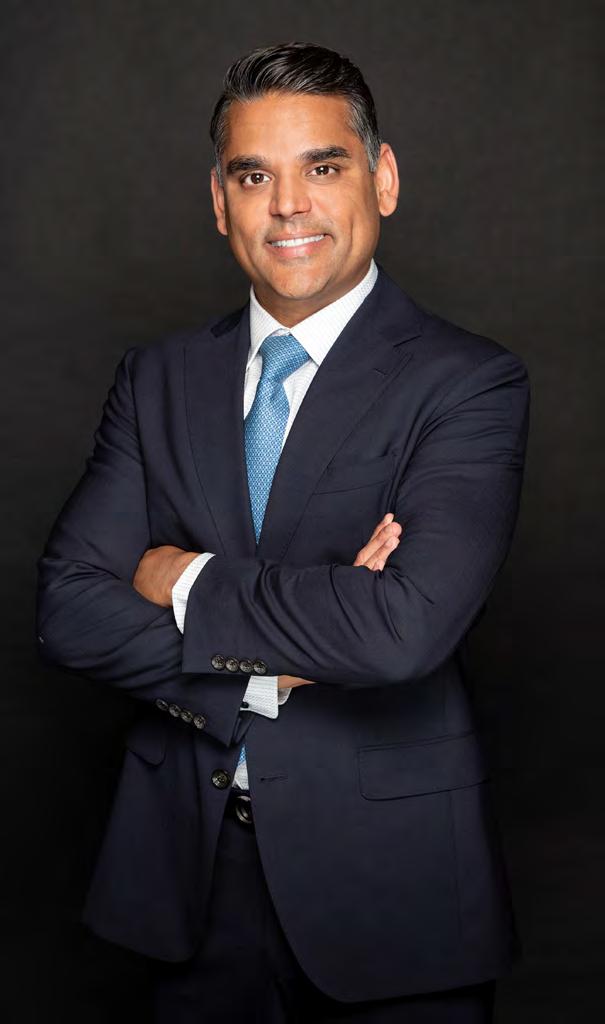
UChicago Medicine AdventHealth Neurological Surgery 908 N. Elm Street, Suite 210, Hinsdale 2363 63 rd Street, Suite 104, Woodridge 630-856-8640
uchicagomedicineadventhealth.org/our-services/ neurosurgery
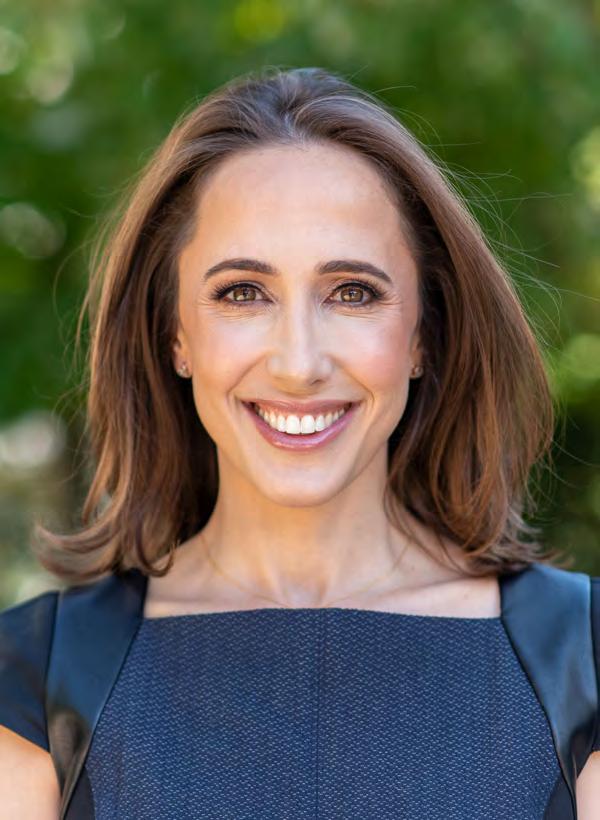
Downers Grove Magazine (DGM): Who were your mentors and how did they influence your current practice?
Dr. Rachel Bognet: I’ve been very fortunate to have worked with many wonderful physicians along the way. From a very young age, I was enamored by my pediatrician, who could make even the sickest child laugh with his comedic routines. Although, it was a summer job in college and volunteer work at the AAD summer camp for children with severe skin conditions that started my love for dermatology. My mentor in residency was most influential in how I practice. He had an unwavering dedication to teaching the basics and a deep understanding of clinicopathologic correlation. This proved vital in how I approach every patient, with a commitment to fixing even the most challenging cases. A dedication to lifelong learning is crucial to being a trusted and compassionate physician.
DGM: How do you stay passionate about medicine, especially after years of practice?
Dr. Bognet: Luckily, this is not difficult as Dr. Steil and I are constantly eager to learn about new technologies and emerging treatments. The plethora of safe and effective medicines we can now offer patients with severe eczema, psoriasis, hair loss, and acne is astounding. When I graduated residency, many of these were not created or an option yet and it has transformed how we can care for patients. Improving patient’s lives and restoring their confidence through groundbreaking medicines and cosmetic treatments is extremely rewarding.
DGM: What makes your practice successful?
Dr. Bognet: Building strong relationships with our patients is at the core of our success. Open and honest dialogue about their medical or cosmetic concerns allows patients to feel at ease. Listening and offering options without judgement or coercion is the foundation of trust in any relationship.
DGM: How do you see the role of precision medicine impacting dermatology in the coming years?
Dr. Bognet: Personalized medicine is already here and changes are rapidly coming due to advances in technology. We now have genomic testing available on skin cancer tissue to better guide the need for immunotherapy and radiation. Genetic testing is also allowing physicians to know which type of medication will be most effective for patients without the antiquted “trial and error” method. Better outcomes with minimal side effects is always the goal.
DGM: If you weren’t a doctor, what would you have wanted to be?
Dr. Bognet: That’s a tough question because I truly love what I do! I suppose when I’m too old to do surgery anymore, I would venture into home remodeling more. I’ve always loved old homes and restoring beauty and balance has always been a passion.
CSC Steil Dermatology
125 W 2nd St, Hinsdale, Illinois and 5157 Main St, 205, Downers Grove, Illinois
630-455-0045
cscdermatology.com
Downers Grove Magazine (DGM): What distinguishes you from other surgeons?
Dr. Michael Byun: I think it’s my understanding of facial anatomy as living tissues in layers. After graduating from Northwestern University Medical School and completing my Plastic Surgery fellowship, for which I was the inaugural fellow of integrated, combined seven year program, I developed a distinct surgical technique, The Byun Lift. Patients who align with my philosophy and seek my specialized skills experience exceptional outcomes. I believe I have a unique understanding of facial anatomy and meticulous surgical direction.
DGM: What is your philosophy, and how did this lead to The Byun Lift technique?
Dr. Byun: I was dissatisfied with the unnatural results of traditional facelift techniques, which often involved skin excision – thus leading to a stretched mouth and fat grafting – resulting in a round, stuffed face. For these reasons, I began exploring alternative approaches as a fellow some 25 years ago. My artistic background provided the dexterity to explore the role of facial muscles in aging. Discovering muscle descent as a key contributor, I developed The Byun Lift.
DGM: What is The Byun Lift?
Dr. Byun: The Byun Lift restores a natural, youthful look by focusing on muscle repair and tissue preservation, addressing both natural aging and/or complications from previous cosmetic procedure results. Unlike the conventional approach, where 99% of surgeons lift facial skin and tissues laterally towards the ears, The Byun Lift technique repositions the muscles upward and inward towards the midline of the face by use of an endoscope. This precise repositioning returns the muscles to their original, pre-aging location, providing a physiologically accurate and superior correction. This method not only lifts but also restores the underlying structures in layers, leading to more natural and long-lasting results. Patients often request The Byun Lift to recapture their youthful appearance, addressing both natural aging and the negative side effects of prior cosmetic procedures.
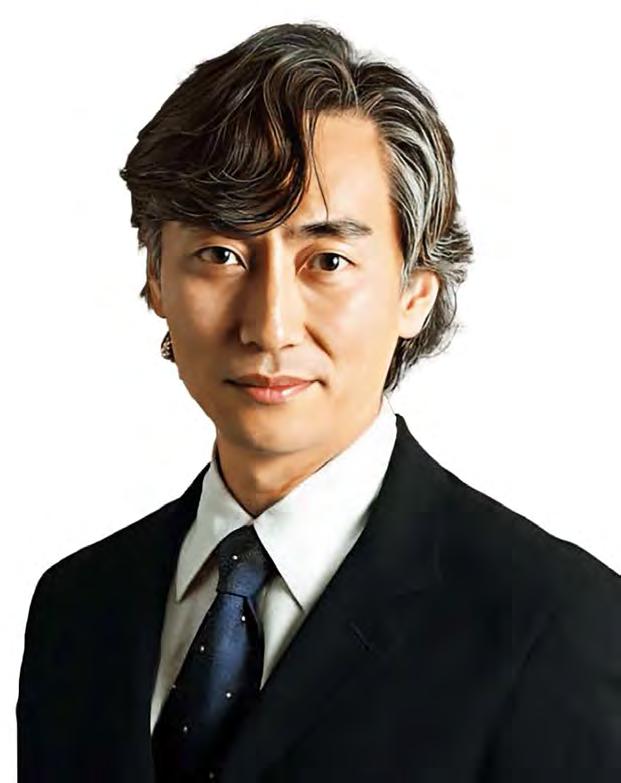
DGM: Can you help patients with problems or complications resulting from other cosmetic procedures or previous facelifts?
Dr. Byun: My specialization, rooted in trauma and pediatric reconstructive surgery, equips me with advanced skills in tissue repair by use of an endoscope. Achieving a natural, attractive correction to reverse what has already been done is contingent on the patient’s existing condition. I offer thorough consultations to educate and guide individuals through their options.
Chicago Cosmetic Surgery 1775 Walters Ave. Northbrook, Illinois (847) 513-6899 chicagocosmeticsurgery.com

Downers Grove Magazine (DGM): What conditions do rheumatologists treat?
Rheumatology Associates: MDs Robert S. Katz, Alexandra Katz Small, and Ben J. Small (RA): We treat rheumatoid arthritis, lupus, ankylosing spondylitis, psoriatic arthritis, osteoarthritis, gout, Sjogren’s syndrome, scleroderma, myositis, vasculitis, polymyalgia rheumatica, fibromyalgia, muscle/joint pain, plus many others.
We specialize in nonsurgical musculoskeletal (bone, joint, muscle and soft tissue) pain-relieving treatment options to those with chronic or temporary conditions.
DGM: What aspects of your careers as doctors are most rewarding?
RA: The most rewarding aspect of medicine is helping people who are sick or in a lot of pain. With the right treatment, patients can improve significantly in terms of pain, swelling and stiffness. Oftentimes they can return to their normal levels of functioning. It is gratifying to know that you have made a significant impact on a person’s health and quality of life.
One of our patients recently commented, “I came to your office in a wheelchair, and I left pushing the wheelchair out.” What a rewarding profession we have helping people. Nothing is more important in life than health, so if we can improve our patient’s quality of life and help them lead happier, healthier lives, we are truly grateful to be in this profession.
DGM: How do you build trust with your patients?
RA: The doctor-patient relationship is the most important aspect of medicine. The best way to build trust is to take the time to really listen and connect with your patients and help them.
The patients are what makes coming to work each day fulfilling. We love helping people improve their quality of life by reducing their pain. We also enjoy getting to know our patients as people, rather than just a medical case or diagnosis.
We all truly love the field of rheumatology. It brings meaning to our lives to be able to help care for others.
DGM: Are there any emerging treatments or therapies that you are particularly excited about??
RA: There are so many exciting new drugs and treatments in the field. Every year many new medicines are developed which improve treatment of rheumatic diseases and dramatically impact our patient’s lives.
Biologic medicines have transformed our field significantly with the reduction of pain and progressive joint damage. Many diseases that were once severe and crippling now have life-changing treatments available. Our office was involved in the trials for Enbrel, the first biologic approved for rheumatoid arthritis. We have published more than 400 research studies.
Rheumatology Associates 2450 S. Wolf Road, Westchester, Illinois 312 226 8228
RheumatologyAssociates.com

Speech-Language Therapy
Physical Therapy • Occupational Therapy
Downers Grove Magazine (DGM): What inspired you to start Pediaprogress and to open an office in Downers Grove?
Pediaprogress: The founder of Pediaprogress, Mindy Vasilakopoulos, was inspired to become a speechlanguage pathologist by her cousin, who has Down syndrome. A graduate of Downers Grove North High School, Mindy set out to create a welcoming space in her hometown, where a community of pediatric experts could provide compassionate care and personalized support for children and their families. Mindy and her husband, George, are raising their three children in Downers Grove.
DGM: What is the mission of Pediaprogress and how do the different types of therapy you offer benefit children?
Pediaprogress: Our mission is to support all children in reaching their potential by engaging their interest, developing crucial skills, fostering critical thinking, and strengthening family relationships. We offer pediatric physical, occupational, speech-language, and feeding therapy for children ages birth to 18 years, both inoffice and with the Early Intervention Program. We support children with a wide range of needs, including torticollis (a condition causing the head to tilt or turn due to tight neck muscles), feeding challenges in infants and children, decreased attention, sensory integration difficulties, sports injuries, muscle weakness, balance and coordination issues, and delays in fine motor, gross motor, and speech/language development.
Our team of licensed physical therapists (PTs), occupational therapists (OTs), and speech-language pathologists (SLPs) begins with a comprehensive evaluation—using standardized tests and parent interviews—to identify each child’s strengths and needs, followed by a personalized treatment plan with goals tailored to their developmental abilities. After the evaluation, we refer to the child’s physician as needed to address potential developmental barriers like sleep or hearing concerns. Using evidence-based practices, therapy activities are individualized to each child’s interests to boost intrinsic motivation, enhance critical thinking, and build essential skills.
DGM: How do you support families in your office and with the Early Intervention (EI) Program?
Pediaprogress: Through in-office private therapy and in-home or daycare-based Early Intervention (EI) therapy, we collaborate with families to support the successful transfer of skills to the home and community. Our team of therapists are credentialed by the State of Illinois EI Program, which provides services for children from birth to three years old, and is available for all eligible children in Illinois, regardless of income level, immigration status, or insurance coverage. We empower caregivers with the tools and knowledge they need to support their child’s development and to integrate strategies into daily routines, such as playtime, dressing, feeding, and bathing. We welcome new families and look forward to meeting you!
Pediaprogress
1101 W 31st Street, Suite 110, Downers Grove, Illinois 630.929.0122 | info@pediaprogress.com pediaprogress.com
Downers Grove Magazine (DGM): How did you decide on your area of specialization?
Dr. Malhotra: I was initially drawn to dermatology because of my own experiences with severe acne and precancerous moles—challenges that allowed me to deeply relate to my patients’ concerns. What ultimately solidified my passion for the field was its unique blend of medical, surgical, and cosmetic care. The skin is a powerful reflection of overall health, and I find great fulfillment in helping patients not only achieve healthier skin but also regain their confidence.
DGM: How do you approach conversations with your patients?
Dr. Malhotra: I approach every patient conversation with empathy, openness, and a genuine desire to understand their concerns. Whether it’s a medical issue or a cosmetic goal, I believe in creating a safe space where patients feel heard and respected. I take the time to listen carefully, explain diagnoses and treatment options clearly, and involve patients in the decision-making process. My goal is to build trust and ensure that every patient leaves feeling informed, supported, and empowered in their care.
DGM: How has technology changed the way you practice medicine?
Dr. Malhotra: Technology has transformed dermatology in incredible ways—from how we diagnose and treat skin conditions to how we connect with patients. Tools like digital dermoscopy, AI-assisted skin analysis, and advanced laser technologies have elevated both the precision and outcomes of care. On the cosmetic side, we now have more refined, non-invasive options than ever before, which means better results with less downtime. Treatments such as Sofwave, Fraxel, Diamond Glow medical facials are just a few of the amazing things we offer.
DGM: How do you stay current with the latest medical research and treatments?
Dr. Malhotra: Staying up to date is essential in a constantly evolving field like dermatology. I regularly attend national conferences, participate in continuing medical education (CME) courses, and stay engaged with leading dermatology journals. I’m also part of professional networks and societies that provide access to the latest clinical guidelines, research, and treatment innovations. Whether it’s a breakthrough in biologics for skin disease or a new cosmetic technique/treatment, I’m always looking to integrate the most effective, evidence-based approaches into my practice to provide the highest standard of care for my patients.

DGM: What’s the one thing you wish patients understood about the medical process?
Dr. Malhotra: I wish more patients understood that healing—whether medical or cosmetic—is often a process, not an instant fix. We live in a world of quick results, but dermatology, in particular, can require patience and consistency. Whether we’re treating acne, managing a chronic skin condition, or working toward aesthetic goals, meaningful results take time and collaboration. I always encourage open communication and realistic expectations, because when patients feel informed and involved, the journey becomes much more rewarding—for both of us.
DGM: How do you maintain a healthy work-life balance?
Dr. Malhotra: It’s definitely a juggling act, but I’ve learned to prioritize the things that recharge me. Running around outside with my two little boys, cheering them on at their games, playing tennis with my husband, or squeezing in a workout (and a good laugh) with my girlfriends—those moments keep me centered. Balance isn’t always perfect, but staying active, connected, and occasionally escaping with a good book or trip helps me show up as my best self, both in the clinic and at home.
SKN Institute
105 S York St # 500, Elmhurst, Illinois
630-349-3040
sknin.com
NO tennis court fee
New for 2025:
• Aqua climbing wall
• Expanding seating and sunbathing area
• New food options plus specialty themed meals and drinks at our Pool Café
Back by Popular Demand:
• Exciting events including Movie Nights, Luau Day, Tie Dye Day and Swim & Save with Wintrust Bank
• Pool Obstacle Course

• British Swim School with professional swim lesson instruction
• Swim Team
• Fluid Running NO initiation fee












• High caliber tennis instruction for both adults & children by professional Ryan Rader


Weekly drills • Social Events • Nike Tennis Camps • Tennis Only Memberships available





afternoon, which was great because we played a 4:00 p.m. game, but it was on tape delay, so nobody in the U.S. watched it in real time. The only people who knew we won were either Canadians, residents of Lake Placid, broadcasters who aired the game or people who had listened to it live on the radio. I don’t know how many people had planned to watch it either because we had lost 10-1 to the Soviets at Madison Square Garden just ten days before we faced them in the Olympics. Most people don’t want to watch a car crash in real time (O’Callahan laughed). But after we won that afternoon, the networks were saying things like, ‘We’re not going to tell you what happened in Lake Placid this afternoon, but be sure you don’t miss it tonight at 8!’
DO YOU REMEMBER THAT MOMENT WELL?
Yes! I’ll never forget it. The stadium was absolutely crazy! People on the street outside were going nuts! The team was all staying in the Olympic Village, but after we played, the hotel where our parents were staying threw us a big party. They put together a few conference rooms, and we had dinner while we watched the game with our families. It was such an amazing night!
BEFORE THE GAME AGAINST THE SOVIETS, COACH BROOKS TOLD THE TEAM, ‘THIS IS WAY MORE THAN A HOCKEY GAME.’ WHAT DO YOU THINK HE REALLY MEANT?
There really was so much more to it than hockey. The country had been through a lot of turmoil in the decades before that game. Most of the guys on that team were born in the 50s. Many of our fathers had fought in the Korean War and were very proud Americans. A generation gap developed in the 60s - an era of racial and social unrest, Vietnam,
Kennedy getting shot, draft dodging, etc. The country was very disconnected. Then we showed up in Lake Placid in 1980, and for two weeks, we played every other night. The momentum built up, and for the first time in a long time, everyone was very proud of the USA again. When we beat the Russians, it really brought the country – and the generations- back together.
WAS THE FINLAND GAME – THE FINAL HOCKEY GAME OF THE 1980 OLYMPICS IN WHICH TEAM USA CAPTURED THE GOLD – AS HARD?
Put it this way, the practice we played after we won the game against the Soviets but before we played Finland was the hardest one we ever had. Coach Brooks never dialed it down. As a matter of fact, it was the opposite. He pushed us so hard that we were like, ‘What is he trying to do? Kill us?’ That’s when he told us, ‘Do you think the Fins are going to lie down and give you this game? You’ve played six games as the underdog. Now you’re the favorite. The world is watching you, and everybody is waiting for you to lose. And if you do, you will take it to your grave!’
He was right. The Fins were a phenomenal team. The last period of that game, to our credit and Coach Brooks’, was probably the best 20 minutes of play in our year together as a team. We were down 2-1 going into the third period, but the Fins barely touched the puck in that last period. We beat Finland 4-2 for the gold!
HOW DO YOU THINK BROOKS’ STYLE OF COACHING AFFECTED THE OLYMPIC VICTORY?
Brooks knew his players well. He had coached most of them at some time before he assembled his Olympic team. He reminded all of us daily that he expected top effort every day. ‘Show up one day and give me 95% and you’ll make my job easy because I’ll get rid of you,’ he always told us. He constantly pushed us and that made us push each other.
I loved playing hockey in high school, and my team at Boston University (BU) won the NCAA tournament. That led to my spot on the Olympic team. While it was the honor of a lifetime, I always knew there would be life after hockey. Even when I was at BU and got drafted by The Blackhawks, the first thing I thought was, ‘If I play in Chicago, maybe I could learn how to trade commodities.’ So, playing hockey got me to where I eventually wanted to be. I now own an asset management firm.
We didn’t really do anything this year to celebrate, but we get together from time to time, and we’re all still close. Our first big reunion was in 2000. I talk to [Mike] Eruzione the most because we’re both from Boston and went to BU together, and now we both live in Florida. I talk to [Rob] McClanahan probably second most. But we’re hockey guys, so we’re all tight. Even Ralph [Cox] and Jack [Hughes], the last two guys who were cut from the roster right before The Olympics, are always included when we meet. We’ll probably do something for the 50th anniversary. ■
Skyvi Pergolas enhance any home with a sleek, customizable design. Available in dimensions up to 23’ x 16’ x 9’, they can be tailored with premium materials and features to complement your space.
With louvered roofs and side panels, Skyvi Pergolas adjust at the touch of a button. Choose from screen fabrics or glass sliding panels to create an enclosed retreat for year-round enjoyment.
Crafted from powder-coated aluminum and reinforced with stainless and galvanized steel, Skyvi Pergolas resist chipping, peeling, and harsh weather— standing strong against winds up to 68 mph. Plus, their ecofriendly production makes them a sustainable choice.
Perfect for patios, rooftops, or backyard escapes, Skyvi Pergolas also elevate commercial spaces, offering stylish outdoor comfort for patrons.
Skyvi Pergolas provide a high-end outdoor experience.



BY ANNA HUGHES
Nicknamed “America’s Hometown,” Cooperstown is more than just a small village in Central New York: It’s a rite of passage for young baseball players across the country. Home to the National Baseball Hall of Fame and one of the most prestigious youth tournaments in the sport, Cooperstown is a mecca for baseball fans and future professional hopefuls. Every summer, thousands of 12-year-old athletes have the chance to showcase their game on one of Cooperstown’s two pristine venues while making memories that last long after their tournament week is over. For many, it marks the peak of their youth careers—and the start of something even bigger.
Susie and Bill Howe’s summers are consumed by baseball, but that’s the way the western suburbs residents like it. Their three sons—Will (15), Andrew (13), and Jake (12)—all play, meaning their calendars are packed with practices and games, along with lots of driving and lots of laundry.
“Last year, I remember…with all three playing, April started, and there were 40 days straight that we had games,” Susie laughed.
The highlight of their recent baseball summers has been trips to Cooperstown. Both Will and Andrew
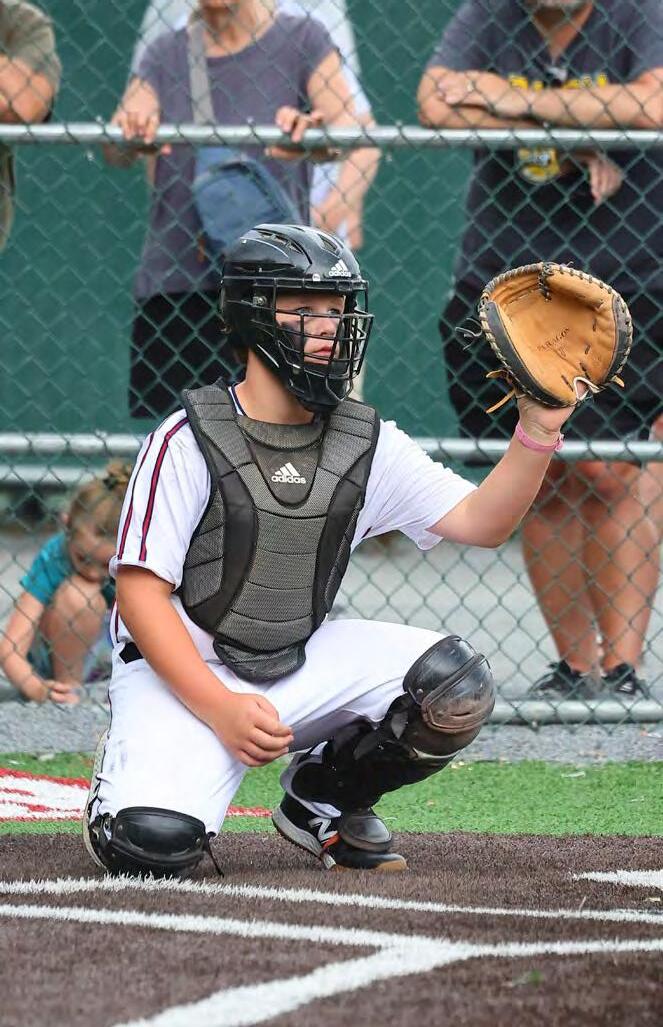
have played in the 12U tournament, during 2022 and 2024, respectively. This summer, it’s Jake’s turn. He’s been counting down since their first visit three years ago.
“The first time we went, nobody had any idea what to expect,” Susie said. “You feel like you’re fundraising, and you’re prepping for this trip, and you’re driving 14 hours, and you get there, and after a few days, you’re like, it’s just really as magical as they say.”
Teams apply to play at Cooperstown over a year in advance and fundraise to help cover the costs, which

include the famous bunkhouses that host players and coaches. Many Cooperstown alumni cite the team bonding and week-long sleepover as lasting memories from the week. For parents, who often stay in nearby campgrounds or hotels, this trip symbolizes a connection with their sons thanks to a shared love of the game.
"Cooperstown is a symbol of baseball's history, and seeing them play there with their friends is a memory I will never forget," Bill said.
His favorite moment was watching Will hit his first home run during the tournament on Andrew’s birthday.
“Seeing the excitement on Will’s face and watching Andrew chase down the home run ball for him is unforgettable for me,” Bill said.
Will remembers that special moment fondly, too.
“It meant a lot to have my dad take me to Cooperstown and cheer me on,” Will said. “He was more excited for me when I hit my home run than I was.”
For the Howe boys and their parents, these are moments that make all the practice hours and busy schedules worth it—and memories that will last long after their youth careers come to an end.
Hinsdalean Luke Adams can attest to that.
Adams (20) is a third baseman for the Biloxi Shuckers, the AA affiliate of the Milwaukee Brewers. Although he’s had almost a decade of baseball experience since his first trip to Cooperstown—including being drafted in 2022 and hitting home runs out of professional ballparks—his time in the bunks stand out among some of his favorite memories.
“Cooperstown was one of, if not the most, special tournaments I’ve ever played in. The atmosphere was phenomenal,” Adams said.
He remembers it as the first time he competed against talented players from across the country—namely places like Florida and California, whose young players benefit from longer baseball seasons thanks to milder weather.
“From the opening day competing against 100+ teams in skill challenges, to playing the Florida Stealth, a powerhouse, at 2 AM because of rain delays that day, to rooming with 12 players and three coaches in a sauna of a room, I had a blast,” Adams said.
Adams had a chance to play in Cooperstown two summers in a row, accompanied by his favorite travel companion and number one fan: his dad, Dan Adams. Dan was one of Luke’s coaches during his second year, which meant enhanced father-son bonding and very busy days.
“The memories of playing so many games in a short period of time, and just the kids bonding and all the fun of being in the bunk house together, it’s got to be one of the top experiences [from Luke’s career],” Dan said.
Dan has been in the bleachers cheering or in the dugout coaching for countless games. To him, Cooperstown stands out as an exceptional playing experience. Between the fabulously-maintained
diamonds and the meticulous attention to detail from umpires and officiating crew, he said the opportunity to play on mini-Major League fields is an unmatched experience for any young player.
“I think that anybody who plays baseball and is serious about baseball at a 12-year-old age should try to go with their team,” Dan said. “It’s one of those once-in-a-lifetime experiences that you get to have as either fatherson or even as a family. I don’t think any kid that plays baseball should miss out on that.”
Although Luke’s killer swing and eye for the game have earned him professional success, it’s moments like Cooperstown that foster the love for the sport. His teammates (three of whom are currently Division I athletes) still keep in touch, telling jokes and marveling at how far they’ve come since their youth baseball days.
“There are still stories to this day we’ll talk about from Cooperstown,” Luke said. ■
“Cooperstown was one of, if not the most, special tournaments I’ve ever played in.”
- LUKE ADAMS

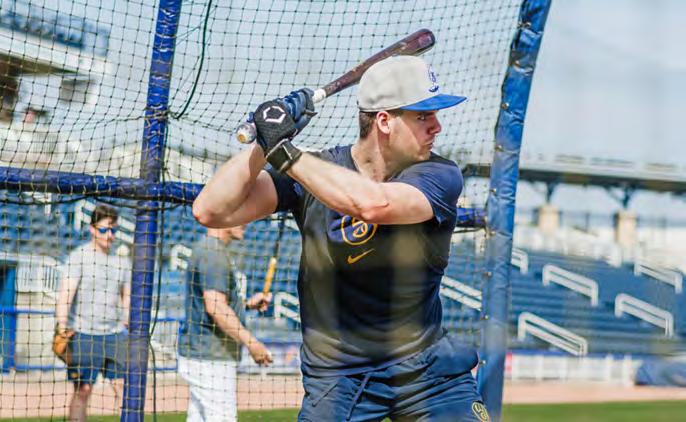

Over hill, over dale, as we hit the dusty trail, and those Caissons go rolling along…
BY MAUREEN CALLAHAN
The United States Army, America’s oldest and largest branch of armed forces, will celebrate its 250th birthday this summer. On June 14, 1775, more than a year before the Declaration of Independence was signed, the Second Continental Congress approved the formation of a militia. It was a time of uncertainty for an unstable, would-be nation that was still finding its footing in a struggle for independence from British rule.
Before formal organization, the thirteen colonies relied on local militias. These groups were part-time soldiers who came together to defend their individual colonies in times of unrest through raids and ambushes. Most relied on their own firearms and possessions and had no formal
military training. As time went on, these ordinary citizens in the local colonial brigades secretly trained to fight the British.
The actual organization of these previously provincial, unstructured - albeit well-intentioned - groups of soldiers became the Continental Army. The brigade was the initial unified force to represent all 13 colonies in the fight for independence during what later became known as the Revolutionary War.
General George Washington, who had garnered military experience and gained notoriety in the colonies during the French and Indian War (1754-58), served as the first Commander-in-Chief of the Continental Army. The Army managed to secure independence through a combination
of strategic battles, guerilla tactics, and the assistance of French allies. Ultimately, the British surrendered at the Battle of Yorktown on October 19, 1781, which ended the war.
In the late 1700s, American patriots recognized the strategic location of the west bank of the Hudson River.
Understanding the significance of its position, Washington commissioned designs for the fortifications built at this location that eventually evolved into the United States Military Academy at West Point. The Academy was founded after the Military Establishment Act of Thomas Jefferson’s presidency. It opened on March 16, 1802.
Today, the Corps of Cadets (student body) numbers around 4,400, with 1300 active-duty soldiers also in

residence. Admission to West Point’s engineering and liberal arts degree programs is very selective, with entrance gained through an appointment made by a U.S. senator or representative.
There are other ways to earn a commission in the U.S. Army - the Army Reserves Officer Training Corps (ROTC)- which offers competitive educational scholarships, the Officer Cadet School, or direct appointments in select legal, medical, ministerial, and technical fields. All applicants are required to be high school graduates, pass a medical and physical exam, and be at least 17 years of age.
Today, the U.S. Army operates with an active component and two reserve modules – the United States Army Reserve and the Army National Guard. Roughly 500,000 soldiers serve actively in the U.S. Army today, with another 550,000 serving in the reserves. The military branch has over 100 installations worldwide, including major bases and smaller outposts.
You only turn 250 once! That said, there will be celebrations all over the country this summer for the Army’s semiquincentennial anniversary. A tribute to the U.S. Army, which highlighted its various eras, rolled through the Rose bowl

Parade in Pasadena this past January in the form of a float entitled: This We’ll Defend: 250 Years of Service.
The U.S. Army Heritage Center Foundation in Carlise, PA, an honored Smithsonian affiliate research library and museum, is planning a birthday dinner on June 14, 2025. Guest speakers and the 28th Infantry Band will entertain ticketholders.
The National Museum of the United States Army in Belvoir, VA, is
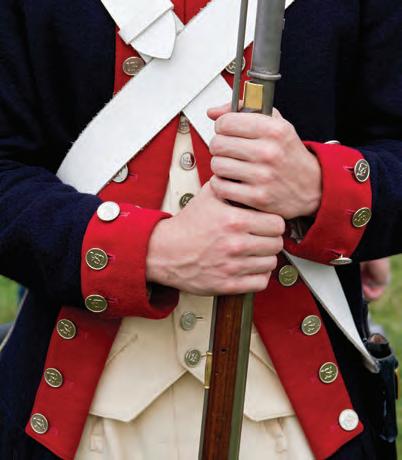
showcasing a special exhibit entitled Call to Arms: The Soldier and the Revolutionary War, which will include a rare collection of Revolutionary War artifacts from the original colonies, as well as England, France, and Canada, along with soldiers’ personal stories from America’s first veterans. The exhibit begins in May and is set to run through the birthday of America in 2026. Virtual attendance is possible.
….For where’er you go, you will always know that those Caissons go rolling along. (From the official song of the United States Army, The Army Goes Rolling Along).
Join Cantigny Park in Wheaton for a day of family fun on Saturday, June 21, from 10:00 a.m. to 4:00 p.m. as they celebrate the 250th Anniversary of the United States Army.
Meet active-duty soldiers, play in an inflatable booth camp, make camouflage crafts, and step back in time to see soldiers’ gear throughout history.
Tours of the First Division Museum, gardens and grounds and Colonel McCormick’s weapon collection are ongoing throughout the year.

Local students are awarded the prestigious Evans Scholarship
BY VALERIE HARDY
Three local high school seniors shot for the green and made it. In this case, “the green” is not on the golf course but rather refers to money, which Downers Grove’s Colin Finn and Elmhurst’s Chloe Cummins and Matthew Hamblin have much more of for college, having recently received the Western Golf Association’s (WGA) Chick Evans Scholarship.
WHAT IS THE EVANS SCHOLARSHIP, AND WHO IS ELIGIBLE TO RECEIVE IT?

The Evans Scholarship provides full tuition and housing funding for students attending a qualifying
four-year university. High school seniors and college freshmen may apply for the Scholarship after successfully completing a minimum of two years as a golf caddie and receiving a nomination from their sponsoring golf club.
In addition to having a strong caddie record, students must have a B-average through their junior year in high school, clearly demonstrate financial need, and consistently display outstanding character, integrity, and leadership to be eligible for the Scholarship.
Evans Scholars live together in a dedicated Evans Scholarship House or on a designated resi-
dence hall floor, so Scholarship applicants are expected to apply to one or more of the 24 Evans Scholarship universities, including the one(s) in their home state if applicable. Once accepted to their colleges, students awarded the Scholarship are matched with a partner college.
Most Evans Scholarship schools are in the Midwest, with the University of Illinois Urbana-Champaign boasting the greatest number of current and alumni Scholars. However, the Program has expanded to colleges across the nation, and a record 1,190 caddies are currently enrolled in college as Evans Scholars, with




an estimated 360 more awarded the Evans Scholarship this year.
The Scholarship was founded by Charles “Chick” Evans Jr., who was introduced to golf while caddying at Chicago’s Edgewater Golf Club in the late 1890s. Evans went on to become one of the nation’s top amateur golfers and was urged to turn professional, but he was not interested in golfing for money. To retain his amateur status, Evans put his golf earnings into an escrow fund, which he decided to use to finance educations for hardworking caddies whose families could not afford college.
In 1928, Evans asked the WGA to oversee the fund, and the first round of Evans Scholarships were awarded in 1930, sending two caddies to Northwestern University. Until World War II, all Evans Scholars attended Northwestern, the site of the first Evans Scholarship House. When Evans’ original investment was exhausted, WGA Directors made contributions of their own to continue the Scholarship Program.
CONTINUE ITS IMPACT TODAY?
The WGA still runs the Evans Scholarship Foundation, which
issued approximately $37 million in Scholarships this year. Evans Scholarships are funded by contributions from over 38,000 Par Club members across the country, proceeds from WGA championship golf tournaments, and donations from some of the more than 12,285 Evans Scholar alumni.
Cummins, Finn, and Hamblin all said receiving the Evans Scholarship has been “life-changing” and working as a caddie has been invaluable.
“Caddying made me so much more confident.”
– MATTHEW HAMBLIN, 2025 NEW EVANS SCHOLAR
Cummins started caddying at River Forest Country Club at age 13 and is one of 11 caddies in her extended family. She said, “I swore up and down that I would never be a caddie – I’m not an outdoorsy person and I don’t like the heat – but I saw my cousins get up and work, making good money and some even got the Evans Scholarship, and I thought it sounded like a good gig!”
Hamblin began caddying at River Forest Country Club as a “shy
freshman” along with friends who decided to try it out as a summer job. “Caddying made me so much more confident, opened many new doors, and helped me…make so many great connections,” he explained.
Finn has caddied at Hinsdale Golf Club for three years and keeps coming back thanks to the “inclusive and supportive members” and the connections he has made with them. Finn also appreciates how flexible caddying is. He runs cross country and track for his school and said, “The Club made it very easy for me to work while having practice every day.”
Finn will attend the University of Illinois to study sports management, Hamblin the University of Iowa to major in finance and accounting, and Cummins Marquette University to major in biomedical sciences.
No prior knowledge of golf is necessary to become a caddie. An orientation program trains new hires on caddying expectations, rules and regulations, and more.
Young men and women interested in caddying may check the club locator on the WGA website (wgaesf.org) to find a participating club.■
BY HINSDALE MAGAZINE GROUP STAFF

Oak Brook will come alive this summer with one of Chicagoland’s most anticipated events—the Taste of Oak Brook. On Thursday, July 3rd, 2025, thousands of people will gather to enjoy an unforgettable evening of food, music, and entertainment. With gates opening at 4:00 p.m., the festivities are sure to captivate visitors from all stages of life.
The Taste of Oak Brook is renowned for offering a unique blend of culinary delights. Last year’s event showcased 16 local restaurants, including favorites like Fogo de Chao, Violi, and Coa, and 2025 is set to raise the bar. Guests will have the chance to sample a diverse mix of flavors and explore Oak Brook’s vibrant dining scene, which includes the beer garden sponsored by Alter Brewing.
A highlight of the event is always the entertainment, and this year is no exception. Music fans will be in for a real treat with two amazing performances. Fearless, the ultimate Taylor Swift tribute band, will take the stage, as will Sixteen Candles, an 80s tribute band.
As the sun sets, the real magic begins. At dusk, the skies over Oak Brook will light up with Chicagoland’s best fireworks show. This year, the event will also feature an expanded drone show.
The Taste of Oak Brook is free to attend, making it accessible and fun for the whole family. Parking for the event will be available in advance, ranging from value parking at $20 to VIP parking at $50.
Visit Oak-Brook.org/Taste for more information.
Hinsdale Magazine Group had the opportunity to speak with Duff Entertainment, who manages the Taste of Oak Brook in partnership with the village.
(HMG): How has the Taste of Oak Brook evolved over the years, and where do you see it heading in the future?
DUFF ENTERTAINMENT (DE):
The Taste of Oak Brook has grown from a dazzling fireworks display for the community into a large-scale, must-attend Fourth of July event for all of Chicagoland. Through our partnership, the event has grown into a highly anticipated annual event that now includes a lineup of live music, exceptional cuisine from local restaurants, drone shows, private cabanas, and the iconic fireworks display everyone has come to love.
HMG: What’s one behind-the-scenes moment in planning Taste of Oak Brook that would surprise people the most?
DE: The amount of work and coordination that goes into an event like this is pretty intensive and isn’t something that’s simply “put together” in a few weeks. The Taste of Oak Brook takes months of intricate planning - from permits and fireworks coordination to drone technology implementation to food, beverage, live music, and everything in between. We’re incredibly proud of the work that is put forth each year to give the community an event to be proud of, however, the amount of time and details behind the event are endless, and we hope attendees appreciate the attention to detail and new elements we incorporate every year.
HMG: What’s the most unexpected challenge you’ve had to overcome while putting this festival together?
DE: When putting together a festival, there are always a lot of unknowns. For example, will attendees like the live entertainment? Will entry and exit be smooth and seamless? We wouldn’t
necessarily pinpoint one challenge, but a lot of little challenges and questions always linger when putting together a large-scale event. However, having amazing working partners like the Village of Oak Brook, as well as the fireworks coordinators, reliable food and beverage vendors, top-notch entertainment and more, help ease a lot of those challenges from the outset.
HMG: How do you go about curating such an entertainment lineup?
DE: When selecting entertainment for events like The Taste of Oak Brook, we really dive into what will resonate with the community. We’re very focused on who attends, what they like, and who will keep people entertained and festive the entire evening. Simply put, we want people to have a great time.
This year, Taste of Oak Brook doesn’t necessarily have a lot of “new” elements, but rather we are expanding upon what we’ve integrated in the past. For example, we will have more VIP tents available for large parties or companies to rent, additional bands and beverage tents will be available, and we’ll be executing a stunning drone show to complement the already impressive 25-minute fireworks display.
In addition, we have expanded the drone show to include over 300 drones to put on a brilliant display ahead of the fireworks show.
HMG: This event brings together a huge team between Duff Entertainment and the Village of Oak Brook— what’s the most rewarding part about working together?
DE: Community is at the core of everything we do, and the reward is seeing the community show up and support their friends and neighbors who orchestrate these events. When you respect the community and team you’re working with, the reward is seeing event attendees
genuinely enjoy themselves. It’s worth it for us to go through some pain points in order to build an event that has longevity and the potential to grow each year. It’s truly an honor to work hand-in-hand with the Village of Oak Brook to put forth events that engage the greater community.
HMG: With so many tastes to cater to, how do you balance creating a diverse menu and keeping everyone happy?
DE: We go by the old saying, “You can’t please everyone,” but we’re surely going to try! We work with trusted food and beverage vendors that offer a wide variety of food to please as many tastes as possible.
HMG: Are there any lesser-known vendors or activities we should keep an eye out for at this year’s event?
DE: All of the names are pretty familiar to locals; however, Alter Brewing + Kitchen has expanded their beer garden this year, where those 21 years and older may enjoy refreshing beverages and unwind in their spacious seating area. Additionally, we introduced the private Cabanas two years ago, and they have been a big hit! We have expanded the private cabana suites to accommodate 75 people and catering by Fogo de Chao - a Chicagoland favorite! The suites have comfortable seating areas, as well as air-conditioned restroom trailers. Cabanas are ideal for large groups that want to entertain clients, employees, family, and friends.
HMG: What should attendees expect regarding the fireworks display?
DE: The Village of Oak Brook is very proud to host one of the longest fireworks displays in Chicagoland. Each year, the Taste of Oak Brook fireworks displays last nearly 25 minutes—which is a lot of bang, boom, and pop! In addition, the 10-minute drone show (featuring 300 drones!) also adds a modern touch of entertainment, awing attendees with their coordinated displays, flickering lights, and more. ■

PHOTOS COURTESY OF THE H FOUNDATION
In February, the H Foundation hosted Comedy for Cancer at The Tivoli Theatre in downtown Downers Grove. The star-studded event featured a comedic conversation with Chelsea Handler, which was led by ABC 7 Meteorologist Cheryl Scott and Ji Suk Yi, co-host of WGN’s Spotlight Chicago. Stand-up comedians Brian Hicks and Vince Carone also delivered performances. Attendees enjoyed a night filled with laughter, community spirit, and generosity, all while supporting the H Foundation’s mission to advance cancer research and improve patient outcomes. The fundraiser generated almost $150,000, nearly doubling the amount raised from past Comedy for Cancer events. All proceeds from the event benefited the Robert H. Lurie Comprehensive Cancer Center at Northwestern University.

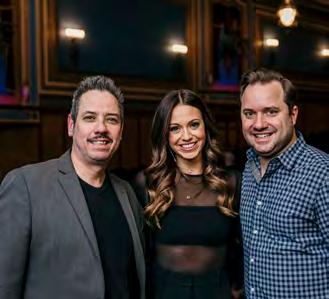


BY CONTRIBUTING PARTNER MAINSTREET REALTORS
As the ground thaws and Chicagoland’s yards begin to awaken, homeowners have a golden opportunity to transform their properties and capture the attention of potential buyers. Curb appeal isn’t just a buzzword—it’s a critical factor that can significantly impact your home’s marketability and final sale price, especially during the busy spring real estate season. Whether you’re looking to sell or just keep your house looking its best this season, here are some tips that can help.
Step
The journey to an eye-catching exterior begins with a thorough assessment. Walk to the street and view your property with fresh eyes. Chicagoland’s communities are known for their distinctive charm. Ensure your home reflects the character and care typical of the community it’s stationed in.
Step
Landscaping is your most powerful tool. After the harsh winter, your yard likely needs some TLC. Start by cleaning up—remove fallen branches, dead leaves, and any winter debris. Then, create a crisp and clean edge around your yard’s perimeter, and consider a fresh layer of mulch in garden beds.
Step
Don’t underestimate the power of pressure washing. Our region’s winters can leave siding, driveways, and walkways looking dingy. A thorough cleaning can make your home look years younger, removing salt stains, mud, and winter grime. Pay special attention to windows—clean, sparkling glass reflects well-maintained pride of ownership.
Color can dramatically transform your home’s exterior. A fresh coat of paint on your front door can work wonders—consider bold yet sophisticated colors like deep navy, forest green, or even pure black to send the message that your home is updated and on-trend. Matching this with updated hardware creates a cohesive and inviting entrance.
Symmetry and strategic landscaping can elevate your home’s visual appeal. While you likely don’t want to invest a ton in landscaping just before you move, there are small things you can do to make a big difference. Potted plants flanking your entrance, well-trimmed shrubs, and a manicured lawn create a sense of order and intentionality. Native plants like purple coneflowers, black-eyed susans, and ornamental grasses thrive in our climate and create maximal impact with minimal cost.
Remember, curb appeal is about creating an emotional connection that helps potential buyers envision themselves in your house. Happy selling! ■



